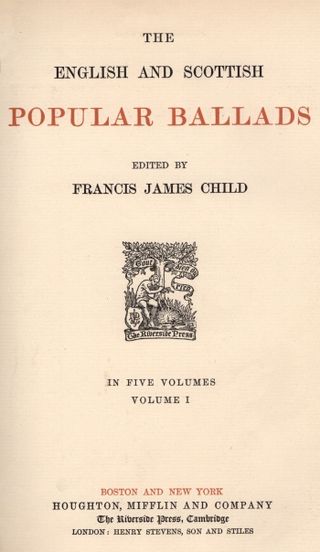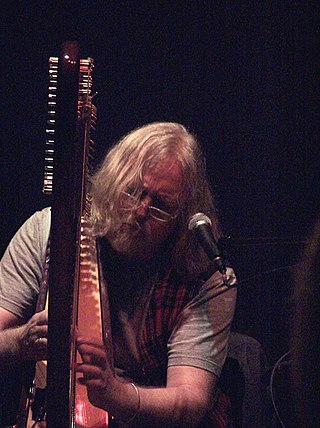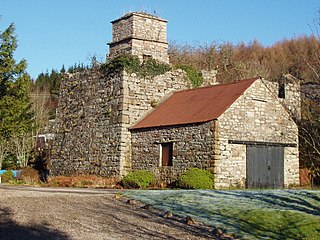
TamLin is a character in a legendary ballad originating from the Scottish Borders. It is also associated with a reel of the same name, also known as the Glasgow Reel. The story revolves around the rescue of Tam Lin by his true love from the Queen of the Fairies. The motif of winning a person by holding him through all forms of transformation is found throughout Europe in folktales.

"Lord Randall", or "Lord Randal", is an Anglo-Scottish border ballad consisting of dialogue between a young Lord and his mother. Similar ballads can be found across Europe in many languages, including Danish, German, Magyar, Irish, Swedish, and Wendish. Italian variants are usually titled "L'avvelenato" or "Il testamento dell'avvelenato", the earliest known version being a 1629 setting by Camillo il Bianchino, in Verona. Under the title "Croodlin Doo" Robert Chambers published a version in his "Scottish Ballads" (1829) page 324.

"The Raggle Taggle Gypsy" (Roud 1, Child 200), is a traditional folk song that originated as a Scottish border ballad, and has been popular throughout Britain, Ireland and North America. It concerns a rich lady who runs off to join the gypsies (or one gypsy). Common alternative names are "Gypsy Davy", "The Raggle Taggle Gypsies O", "The Gypsy Laddie(s)", "Black Jack David" (or "Davy") and "Seven Yellow Gypsies".

Robin Duncan Harry Williamson is a Scottish multi-instrumentalist, singer, songwriter, and storyteller who was a founding member of The Incredible String Band.

"The Twa Sisters" is a traditional murder ballad, dating at least as far back as the mid 17th century. The song recounts the tale of a girl drowned by her jealous sister. At least 21 English variants exist under several names, including "Minnorie" or "Binnorie", "The Cruel Sister", "The Wind and Rain", "Dreadful Wind and Rain", "Two Sisters", "The Bonny Swans" and the "Bonnie Bows of London". The ballad was collected by renowned folklorist Francis J. Child as Child Ballad 10 and is also listed in the Roud Folk Song Index ., Whilst the song is thought to originate somewhere around England or Scotland, extremely similar songs have been found throughout Europe, particularly in Scandinavia.
"The Maid Freed from the Gallows" is one of many titles of a centuries-old folk song about a condemned maiden pleading for someone to buy her freedom from the executioner. Other variants and/or titles include "The Gallows Pole", "The Gallis Pole", "Hangman", "The Prickle-Holly Bush", "The Golden Ball", and "Hold Up Your Hand, Old Joshua She Cried." In the collection of ballads compiled by Francis James Child in the late 19th century, it is indexed as Child Ballad number 95; 11 variants, some fragmentary, are indexed as 95A to 95K. The Roud Folk Song Index identifies it as number 144.
"Young Beichan", also known as "Lord Bateman", "Lord Bakeman", "Lord Baker", "Young Bicham" and "Young Bekie", is a traditional folk ballad categorised as Child ballad 53 and Roud 40. The earliest versions date from the late 18th century, but it is probably older, with clear parallels in ballads and folktales across Europe. The song was popular as a broadside ballad in the nineteenth century, and survived well into the twentieth century in the oral tradition in rural areas of most English speaking parts of the world, particularly in England, Scotland and Appalachia.
"The Cruel Brother" is a folk song.
"Edward" is a traditional murder ballad existing in several variants, categorised by Francis James Child as Child Ballad number 13 and listed as number 200 in the Roud Folk Song Index. The ballad, which is at least 250 years old, has been documented and recorded numerous times across the English speaking world into the twentieth century.
Johnie Cock is a traditional Scottish folk ballad, listed as the 114th Child Ballad and number 69 in the Roud Folk Song Index.

Furnace is a village in Argyll and Bute, on the west coast of Scotland, on the north shore of Loch Fyne, the longest sea loch in the United Kingdom. Furnace is around eight miles southwest of Inveraray on the A83 road.
Dr John Lorne Campbell FRSE LLD OBE was a Scottish historian, farmer, environmentalist and folklorist, and recognized scholar of both Celtic studies and Scottish Gaelic literature.
Belle Stewart, born Isobella McGregor, was a Scottish Traveller traditional singer. Her biography, Queen Amang the Heather: the Life of Belle Stewart, was written by her daughter, Sheila Stewart, and published in 2006.

Jack is an English hero and archetypal stock character appearing in multiple legends, fairy tales, and nursery rhymes.

Oral storytelling is an ancient and intimate tradition between the storyteller and their audience. The storyteller and the listeners are physically close, often seated together in a circular fashion. The intimacy and connection is deepened by the flexibility of oral storytelling which allows the tale to be moulded according to the needs of the audience and the location or environment of the telling. Listeners also experience the urgency of a creative process taking place in their presence and they experience the empowerment of being a part of that creative process. Storytelling creates a personal bond with the teller and the audience.

Stanley Robertson was a Scottish storyteller, author, ballad singer, and piper.
John D. Niles is an American scholar of medieval English literature best known for his work on Beowulf and the theory of oral literature.
The Dewar Manuscripts are a collection of oral folktales of the Scottish Highlands, recorded in writing between 1863 and 1871 by John Dewar. Dewar's writings were first translated from Gaelic to English in 1879 and since then have been published in multiple formats. The collection of the folktales was intended to ensure that they were not forgotten by the population of the Scottish Highlands, and the manuscripts serve today as both a cultural record and historical source.
Linda Jane Williamson is an American-born academic who specialises in the lore of Scotland's travelling people. She is credited with bringing the stories of traveller Duncan Williamson to a wider audience.
Betsy Whyte, née Townsley (1919-1988), was a Scottish traveller. She was an accomplished singer and a noted virtuoso of traditional Scottish storytelling. Recordings of her performances are held in the permanent collection of the School of Scottish Studies, part of the University of Edinburgh. She wrote her autobiography in two parts: Yellow on the Broom, published in 1979, and its sequel, Red Rowans and Wild Honey, published posthumously in 1990.









